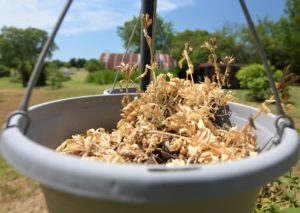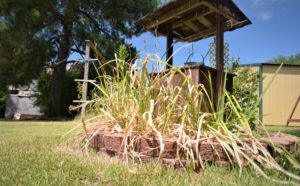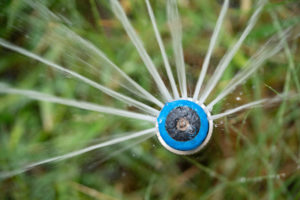Tips for gardeners during a Texas heat wave
Record temperatures push limits of plant survival
Summer is always a challenging time for Texas ornamental and vegetable gardens, but a record heat wave and drought have made it especially difficult to keep plants from turning brown and crispy. So, how can we manage our gardens until rain and cooler temperatures bring relief?

Michael Arnold, Ph.D., director of The Gardens and professor in the Texas A&M College of Agriculture and Life Sciences Department of Horticultural Sciences, has some good tips gardeners should abide as the dog days of summer set in.
“Conditions are severe. If we were dealing with typical heat and mild drought, I would say ‘Be patient,’ but we are dealing with an extended period of drought and extreme heat stress,” he said. “The priority might be to keep vegetables producing or to salvage ornamentals and make sure our perennials and trees see another year.”
Arnold said these are generalized recommendations, and gardeners should seek local assessments and advice from Texas A&M AgriLife Extension Service agents and/or horticulturists sooner than later in some cases where high-value plants and trees are stressed.
Take care of yourself first during heat wave
Safety should always be the top priority for home gardeners, Arnold said. While plants, landscapes and gardens are a concern, gardeners should be mindful to avoid overexertion and heat- or sun-related injury as they tend them.
To stay cool, Arnold recommends wearing a broad-brimmed hat and loose-fitting, breathable, light-colored clothing and to complete more strenuous activities in the early morning hours while temperatures are cooler. Sunscreen is always a good addition to avoid sunburn and overexposure.
But two of the most important precautions to take during extreme heat are staying hydrated by drinking plenty of water and avoiding alcoholic and caffeinated drinks and taking intermittent breaks to cool down inside or in a shady, breezy location.
“Think of breaks as strategy time where you can plan your efforts,” he said. “I also recommend a garden buddy in extreme heat. You can keep an eye on each other, and it gives you someone to complain about the weather with.”
Keeping plants alive during heat wave, drought
To save gardens and landscapes, Arnold said the obvious solution is irrigation. But managing water resources wisely is critical for plants, water costs and to conserve a finite resource.

“Once we pass the upper-90s during the day and mid-70s at night, plants can struggle with natural processes like photosynthesis, and that reduces vigor and increases susceptibility to other stresses. We’re just looking to reduce as much stress as possible by watering and tending to the plants’ individual needs while avoiding adding stress.”
Drip and low-flow irrigation, such as spray stakes below the plant canopy or bubblers, are advantageous, Arnold said. They reduce evaporative water loss, help prevent overspray on foliage and provide directed application to an area or individual plants. They can also be hidden from view.
Mulching helps to conserve applied soil moisture, Arnold said. Placing 2-3 inches of leaves, straw, homemade mulching mixes or bagged products around plants and trees helps provide a layer to protect and preserve soil moisture.
A light application of organic mulch over drip lines, not more than 2-3 inches deep, can help reduce moisture loss from the soil, Arnold said, but excessive mulch applications can impede water filtration and gas exchanges needed for healthy plant root growth.
Remember to check the system’s water pressure when using low-flow irrigation, he said. If the pressure is higher than recommended, installation of an inexpensive pressure regulator will save headaches from blown drip lines.
Arnold said to be sure to monitor both landscapes and vegetable gardens for pest and disease infestations because heat- and drought-stressed plants may be more susceptible to infections.
“A well-watered and maintained garden attracts many insects and insect predators,” he said. “But the benefit to gardening and helping vegetables and flowers through a tough summer, beyond the production and aesthetics, is you’re providing an oasis for native pollinators and honeybees.”
Timing is everything
Timing is an important factor for overhead and spray water applications, especially for larger areas like turfgrass, Arnold said. Watering during the morning or evening hours reduces losses to evaporation. Be sure and allow time for leaf surfaces to dry before dark to avoid fungal pathogen infections on foliage.
In areas of the state with salty irrigation water, Arnold said it is critical to avoid contacting the foliage during irrigation because leaves are much more sensitive to salt exposure than the roots of most plants, he said. Subcanopy application methods will reduce the adverse impact of salty irrigation water.
This also applies if a gardener is using recycled water as irrigation because these sources are often high in dissolved salts, Arnold said. Plants vary tremendously in their ability to tolerate salt exposure, so it is important to reserve the best quality water, such as captured rainwater, for use on the most sensitive plants.
“Regardless of the application technology you choose to use, the best results typically occur when we water thoroughly, but less frequently,” he said. “This encourages deeper root development and helps to wash any accumulated salts out of the upper layers of the soil where most of the roots develop.”

Moisture monitoring devices can help with timing of irrigation, but for landscape beds, vegetable gardens and containers, Arnold said the finger method is pretty reliable. Push your finger in the soil or pot substrate, if it is moist, there is no need to water, but if the soil is dry, apply water.
For the lawn, seeing footprints when you walk is a sign that grass may need water. The efficiency of overhead water applications can be maximized by performing an irrigation audit and making needed adjustments to risers or sprinklers and run times.
Arnold said gardeners should test their soil before applying fertilizers. Frequent irrigations can leach minerals from the soil, but it is important to avoid over-applying fertilizers because they contribute to salinity issues.
“Fertility and irrigation can be tricky in this type of drought,” he said. “You can love plants to death or create a victim by trying to keep other plants alive. These are the considerations that may require some specific regimens.”
Planning for future heat waves
Arnold said saving plants this summer will take prioritization, time, effort and likely a higher water bill. But gardeners can plan for future heat waves by introducing heat- and drought-tolerant plant varieties and choosing beneficial planting sites for more sensitive plants.
“Selecting heat-tolerant plants like tropicals and summer-loving annuals will improve success,” he said. “Many xeric plants suited for the Hill Country and West Texas can be winners in the severe heat.”
Many Texas Superstar plants display drought- and heat-tolerant characteristics because varieties chosen for the designation perform under summer conditions across the state, Arnold said.
Xeric plants will need locations with good drainage to avoid root rot due to saturated soils, he said. This can be a concern when balancing turfgrass water needs with sensitive plants and trees like post oaks, which can be easily overwatered.
On the other hand, placing plants in locations that receive afternoon shade can also help varieties that prefer milder conditions, Arnold said. Emergency shade can be provided to sensitive plants by erecting shade cloth over them, but be sure to avoid direct contact of the shade cloth with the foliage.
A similar strategy can be applied with ornamental plants, shade and fruit trees and vegetable gardens, he said. Plants like okra and peppers thrive in the heat provided they have sufficient soil moisture. Vegetable gardens are ideal locations for drip and low-flow irrigation uses.
“It’s a stressful time for our plants and trees, and that can put pressure on gardeners and homeowners,” he said. “There are different philosophies to planting and maintaining gardens and landscapes, and I think it comes down to personal preference regarding how much time, energy and resources we employ to achieve our goals. But it shouldn’t add to our stress.”


